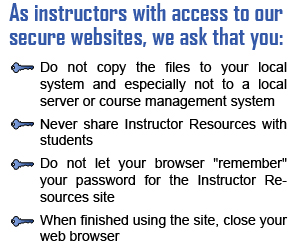|
|
It has come to our attention that there are students
who have found a way to access the Instructor
Resources for both Foundations of Chemistry and
Solving Real Problems with Chemistry. While we have
been able to have that content
successfully
pulled
from several anonymous file sharing sites, the fact is
that once the content is "out there", there's only
so much we can do.
One thing we can and will do is change the
location of the current Instructor Resources and
generate all new User Names and Passwords
combinations for all
adopting instructors.
These instructors will receive
notfication once the new content is available (at
during December
2014). |
 |
We appreciate the frustration that instructor feel, as they
endeavor to teach their students, only to be met with
students who think they already have the answers. There is,
after all, a world of difference between passing a class or
exam and learning content.
As aggrivating as this
situation is, there are a couple of strategies that we
encourage you to consider using, should you suspect your
students of cheating (or even if you just want to ensure
that they're truly working with and struggling to learn
course
content).
Validation : Having the answer isn't enough. Neither is
showing your work and how you arrived at the answer. If you
ask students to validate their work, they must find a way to
check that answer. There are various validation techniques:
Working
backwards (such as using division to
validate the answer to a multiplication problem)
Applying the solution
to the problem (demonstrating that the
solution satisfies the conditions of the problem)
Using a second
process to solve the problem
(examples include serial addition as an alternative
process to validate multiplication or finding the
intersection of lines graphically to validate the
intersection found algebraically)
Changing quantitites :
Simply substitute numbers, amounts, quantities, etc., for
what appears in the problems or questions in the book.
Identify and Correct the Error: Give students a sample
answer to a problem or question and ask them to determine if
it is correct or incorrect, and why.
Finally, explicitly addressing the issue and
ensuring that students know
what they risk by cheating and
being academically dishonest isn't a bad idea. |




